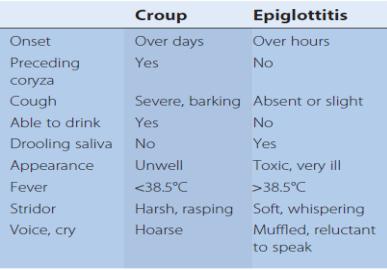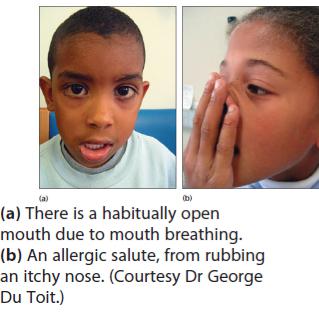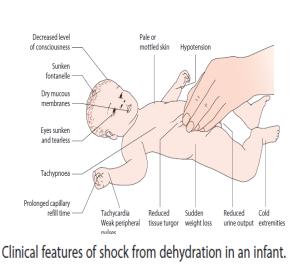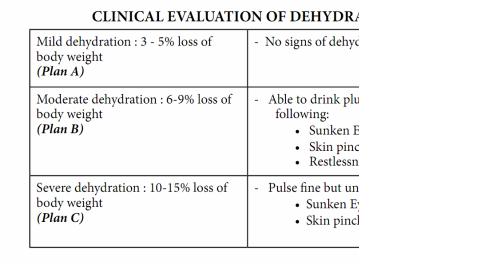
Pediatrics(2)
.pdf-Progressive Laryngeal dyspnea
-Sore throat
-Hoarseness of voice
-Stridor
-Barking cough
-Fever
-Erythema and Edema of larynx Complications
-Severe respiratory distress
-Secondary infection
-Airway obstruction Investigation
-Unless there are signs of secondary infection Management
Non Pharmacological management
• Humidified O2 therapy
• Plenty of fluids Pharmacological treatment
• Adrenaline nebulisation 0.5ml/kg [of diluted 1:1000 (1 mg/ml)] in 3 ml Normal saline. Maximum dose 2.5ml for ≤ 4yrs old and maximum 5ml for > 4yrs old.
• Dexamethasone IM 0.3-0.6mg/kg per dose x 2/day/2days or Prednisolone PO 1-2mg/kg/day divided in 2 doses (Maximum dose 50mg in 24hrs) Recommendation
-Patients who don’t improve after treatment should be intubated

1.4.8. Epiglottitis Definition: Acute epiglottitis is a life-treatening
emergency due to respiratory obstruction. It is due to intense swelling of epiglottis and surrounding tissues with septic signs.
Cause
- It is caused by Haemophilus influenza type b. Since systematic vaccination, this condition has become very rare
Management
-Urgent hospital admission and treatment
-Move the child only when ready for intubation under anesthaesia
-Intubation by senior anesthaesist, paediatrician and ENT in surgical room
-Urgent tracheostomy if intubation impossible
-Antibiotic treatment: cefotaxime IV 30-50 mg/kg/dose Q8h for 7-10 days
Or
-ceftriaxone IV 100mg/kg/dose Q24h for 7-10 days
-1.4.9. Pertussis (Whooping Cough)
-Definition: this is a highly infectious form of bronchitis caused by
-bordetella pertussis. It has become rare since vaccination but it is endemic with epidemics every 3-4 years. Particular attention should be paid to young infants (before complete vaccination), adults (weaning effect of vaccine) and unvaccinated.
-Cause
-- Bordetella pertussis
-Signs and Symptoms
-- After one week of coryza (catarrhal phase), the child develops a characteristic paroxysmal cough followed by characteristic inspiratory whoop (paroxysmal phase, 3-6 weeks). It worsens at night with occasional vomiting.during paroxysm, the face goes red or blue and mucus flows from nose and mouth. It may cause apnea in young infants.
-The symptoms gradually decrease and may persists for months
(convalescent phase)
-Investigations
-- Culture if available
-- FBC: marked lymphocytosis (>15 *10^9/l)
-Management
-- Admit to hospital if infant (risk of apnoea)
-- Symptomatic treatment: O2, Naso-Gastro tube feeding
-- Erythromycin 15-20 mg/kg/dose Q8h for 14 days.
-Or
-- Azitrhomycin, Infants aged <6 months: 10 mg/kg/dose Q24h for 5 days.
-• Infants and children aged >6 months: 15 mg/kg (maximum: 500 mg) on day 1, followed by 10 mg/kg/dose Q24h (maximum: 250 mg) on days 2-5
-Recommendation
-- Prophylaxis for close contacts
-1.4.10. Allergic Rhinitis

-
-Definition: It is an inflammation of the mucous lining of the nose dueto hypersensitivity to inhaled allergens
-Causes
-- Allergy with common predisposing factors that include pollutin environment, dust, fumes, animals
-- Overuse of nasal decongestants (Rhinitis medicamentosa)
-- Viral infection
-- Bacterial infection secondary to viral infection
-Signs and Symptoms
-- Nasopharyngeal discomfort with nasal congestion
-- dry cough
-- Headache
-- Watery eyes
-- Sneezing and watery running nose
-- Sensation of nasal obstruction
-- Asthenia
-- Thick, sticky mucus (after 3-days)
-Complications
-- Otitis media
-- Sinusitis
-- Pharyngitis
-- Laryngo-bronchitis
-Investigations
-- Blood tests for allergens (Serum immunoassays for specific IgE)
-- Skin testing for specific allergens
-- Nasal smears for specific allergens
-Management
-- Avoid allergens
-- There is no cure for the common cold; treatment is given for symptom relief
-- Supportive care includes bed rest and drinking plenty of fluids
-Treatment of first choice
-• 2-5 years : chlorpheniramine tabs/syrup :1mg x3/day/1-3 days
-• 6-11years: chlorpheniramine tabs/syrup: 2mg x3/day/1-3 days
-• 12 years: chlorpheniramine tabs/syrup: 4mg x3/day/1-3 days
-• nasal steroids, 1-2 spray/nostril/dose Q1224h
-• Avoid local nasal decongestants as they have long term side effects
-Alternative treatment
-• claritine tabs/syrup
-→ Children 2 to 12 years of age: Body Weight > 30 kg, 10 ml [10 mg], (two 5 ml spoonful)
-→ Children : Body Weight 30 kg; 5 ml [5 mg],
(one 5 ml spoonful
-→ Children 12 years of age and over: One tablet [10 mg] once daily or 2- 5 ml spoonful [10 mg] once daily
-Or
- • cetrizine
-→ Children 6 months to <2 years: 2.5 mg (½ teaspoon) once daily
-→ Children 2 to 5 Years: 2.5 mg (½ teaspoon) syrup once daily increased to a maximum dose of 5 mg per
-day given as 1 teaspoon syrup once a day or one ½ teaspoon syrup
-→ Children 6 to 11 Years: 5 mg or 10 mg once daily depending on symptom severity
-→ Children 12 Years and Older: 5 mg or 10 mg per day
-
Dr: Essam Abdullah 01123232188
-2. Gastro-intestinal Disorders
-2.1. Acute Gastroenteritis
-Definition: Gastroenteritis is an inflammation of the stomach and
-intestines that causes diarrhea, vomiting, nausea and other symptoms
-of digestive upset. diarrhea is the passage of three or more loose or watery stools per day.
-It can be watery, bloody or containing mucus.
-Causes
-- Viral gastroenteritis: Rotaviruses are the most likely cause of
-infectious diarrhea in children under age 5
-- Bacterial gastroenteritis: Campylobacter, Salmonella or E. coli
-- Intestinal parasites: Giardia lamblia
-- Other causes include life threatening conditions that may be
-initiated by diarrhea: intussusceptions, appendicitis
-Signs and Symptoms
-CLINICAL EVALUATION OF DEHYDRATION
-

-  - Complications
- Complications
-
-
-- Hypovolemic shock: (Tachycardia, cold hands, weak or absent pulse, capillary refill > 2 seconds, not alert)
-- Electrolytes imbalance: severe hyponatremia (<130mmol/L), severe hypernatremia (>150mmol/L), severe hypokalemia (<3mmol/L)
-- Cerebral œdema: (headache, convulsions, vomiting, nausea, weakness) due to rapid rehydration with hypotonic solutions
-- Intracerebral haemorrhage: due to severe dehydration in infants and young children
-Investigations
-- Stool exam: direct/culture (if blood or pus in stool)
-- FBC, CRP, Hemoculture if suspicion of bacterial blood stream
-- Electrolytes (Sodium and Potassium)
-- Glyceamia, urea/Creatinine if shock
-Note: Qualitative evaluation of dehydration (according to natremia)
-- Isotonic dehydration: Na 130 to 150 mmol/L
- - Hypertonic dehydration: Na > 150 mmol/L
-- Hypotonic dehydration: Na < 130 mmol/L
-Management
-- Admit the child: Absolute criteria of admission:
